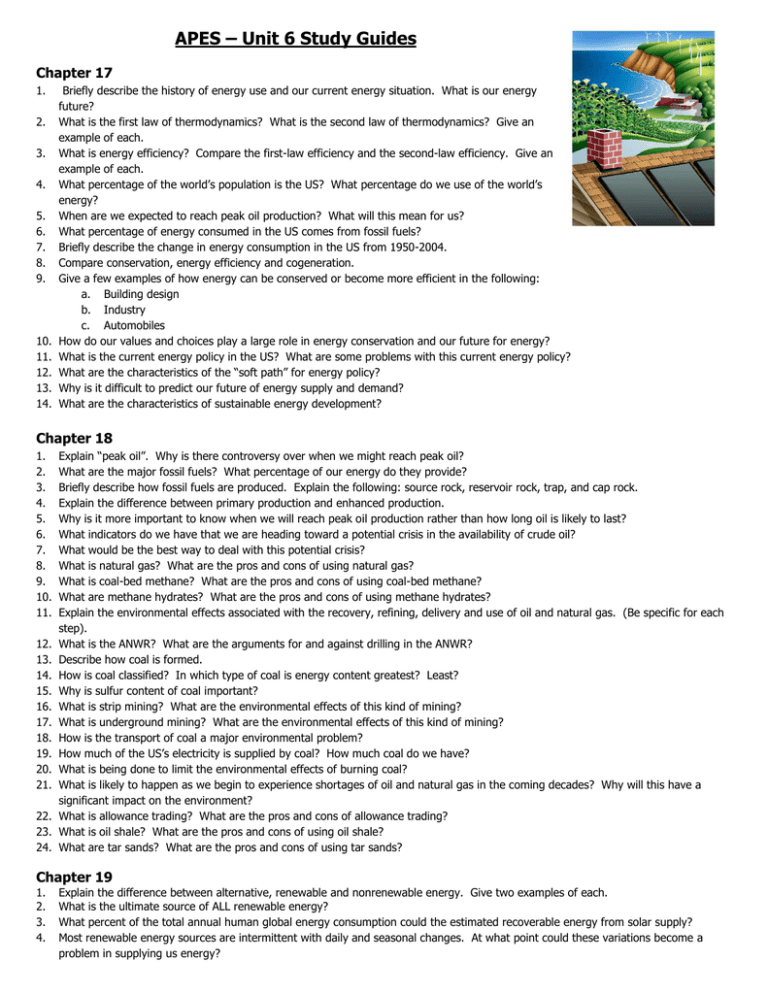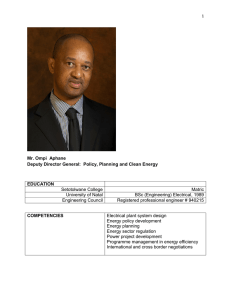APES – Unit 6 Study Guides
advertisement

APES – Unit 6 Study Guides Chapter 17 1. 2. 3. 4. 5. 6. 7. 8. 9. 10. 11. 12. 13. 14. Briefly describe the history of energy use and our current energy situation. What is our energy future? What is the first law of thermodynamics? What is the second law of thermodynamics? Give an example of each. What is energy efficiency? Compare the first-law efficiency and the second-law efficiency. Give an example of each. What percentage of the world’s population is the US? What percentage do we use of the world’s energy? When are we expected to reach peak oil production? What will this mean for us? What percentage of energy consumed in the US comes from fossil fuels? Briefly describe the change in energy consumption in the US from 1950-2004. Compare conservation, energy efficiency and cogeneration. Give a few examples of how energy can be conserved or become more efficient in the following: a. Building design b. Industry c. Automobiles How do our values and choices play a large role in energy conservation and our future for energy? What is the current energy policy in the US? What are some problems with this current energy policy? What are the characteristics of the “soft path” for energy policy? Why is it difficult to predict our future of energy supply and demand? What are the characteristics of sustainable energy development? Chapter 18 1. 2. 3. 4. 5. 6. 7. 8. 9. 10. 11. 12. 13. 14. 15. 16. 17. 18. 19. 20. 21. 22. 23. 24. Explain “peak oil”. Why is there controversy over when we might reach peak oil? What are the major fossil fuels? What percentage of our energy do they provide? Briefly describe how fossil fuels are produced. Explain the following: source rock, reservoir rock, trap, and cap rock. Explain the difference between primary production and enhanced production. Why is it more important to know when we will reach peak oil production rather than how long oil is likely to last? What indicators do we have that we are heading toward a potential crisis in the availability of crude oil? What would be the best way to deal with this potential crisis? What is natural gas? What are the pros and cons of using natural gas? What is coal-bed methane? What are the pros and cons of using coal-bed methane? What are methane hydrates? What are the pros and cons of using methane hydrates? Explain the environmental effects associated with the recovery, refining, delivery and use of oil and natural gas. (Be specific for each step). What is the ANWR? What are the arguments for and against drilling in the ANWR? Describe how coal is formed. How is coal classified? In which type of coal is energy content greatest? Least? Why is sulfur content of coal important? What is strip mining? What are the environmental effects of this kind of mining? What is underground mining? What are the environmental effects of this kind of mining? How is the transport of coal a major environmental problem? How much of the US’s electricity is supplied by coal? How much coal do we have? What is being done to limit the environmental effects of burning coal? What is likely to happen as we begin to experience shortages of oil and natural gas in the coming decades? Why will this have a significant impact on the environment? What is allowance trading? What are the pros and cons of allowance trading? What is oil shale? What are the pros and cons of using oil shale? What are tar sands? What are the pros and cons of using tar sands? Chapter 19 1. 2. 3. 4. Explain the difference between alternative, renewable and nonrenewable energy. Give two examples of each. What is the ultimate source of ALL renewable energy? What percent of the total annual human global energy consumption could the estimated recoverable energy from solar supply? Most renewable energy sources are intermittent with daily and seasonal changes. At what point could these variations become a problem in supplying us energy? 5. 6. 7. 8. 9. 10. 11. 12. 13. 14. 15. 16. 17. 18. 19. 20. 21. 22. 23. 24. 25. 26. 27. 28. 29. 30. 31. 32. 33. Explain the difference between passive and active solar energy systems. Give a few examples of each. Briefly describe how solar collectors work. Briefly describe how photovoltaics work. Briefly describe how a solar power tower works. What is the Luz International solar system? How much electricity does it supply? Why is this system so successful? What are the environmental concerns of utilizing solar power? How can hydrogen be used as a fuel source? What is the combustion product of burning hydrogen? How can we produce hydrogen? How is water power considered a form of stored solar energy? Explain the difference between traditional hydroelectric power plants (like Folsom) and micro-hydropower systems? Which do you think would be better? What are the environmental concerns of utilizing water power? Briefly describe how tidal power works. Where can tidal power be utilized? What are the environmental impacts of tidal power? Describe the basics of wind power. What types of locations would be best for utilizing wind power? What are the environmental concerns of wind power? How much of our energy needs could be met by wind power? List 5 sources of biofuel. How can methane be formed and utilized? What is ethanol? How is it made? How can urban waste be utilized to generate electricity? What are the environmental concerns of using biofuels? How much electricity could potentially be provided utilizing biofuel crops in the next 20 years? Describe how geothermal systems work. What locations have potential for geothermal energy systems? What are the environmental concerns of utilizing geothermal energy? How much electricity could known geothermal reserves produce in the future? What are the policy issues involved with utilizing more renewable energy in the future? Chapter 20 1. 2. 3. 4. 5. 6. 7. 8. 9. 10. 11. 12. 13. 14. 15. 16. 17. 18. 19. 20. 21. 22. 23. 24. Explain the difference between nuclear fission and fusion. How do we currently utilize nuclear reactions as an energy source? Besides electricity for homes and industry, what else do we utilize nuclear power for? What are the three types of uranium isotopes that occur in nature? Which type of uranium is used in the production of nuclear energy? Describe how fission reactors work to produce energy. What is radioactive decay? What is half=life? How is it calculated? If we start with 1 g of U-235 (which has a half-life of 700 million years), how long would it take until we had .125g of U-235? What are the three major kinds of nuclear radiation? What has caused all major nuclear accidents? How can nuclear power be used to create hydrogen for fuel cells? How efficiently does our current technology use uranium? What are future possibilities that can increase the efficiency? Briefly describe how a pebble reactor works. What is the future of nuclear fusion as an energy source? Describe 7 environmental issues/concerns of using nuclear energy. How is radiation measured? How are people exposed to radiation naturally? What are the effects of radioisotopes on the environment? What are the health effects associated with radiation exposure? Why is it difficult for scientists to determine the point at which exposure becomes hazardous to human health? Describe the nuclear power accidents that occurred on Three Mile Island and Chernobyl. What is low-level radioactive waste? Give some examples. How is it disposed of? What are some issues with how we currently dispose of it? What is transurnic waste? Give some examples. How is it disposed of? What are some issues concerned with its disposal? What is high-level radioactive waste? Give some examples. How is it disposed of? What are some issues concerning its disposal? What is the future of nuclear energy? Why is nuclear a good choice as an alternative energy?
